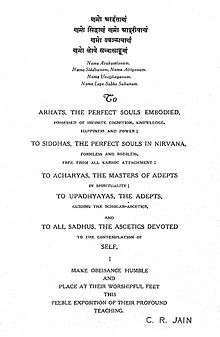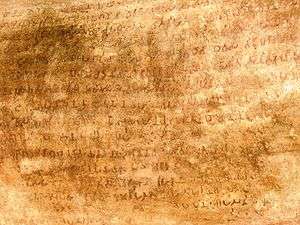Namokar Mantra
| Namokar Mantra | |
|---|---|
 Ṇamōkāra mantra | |
| Information | |
| Religion | Jainism |
| Language | Prakrit |
| Part of a series on |
| Jainism |
|---|
 |
|
Jain prayers |
|
Ethics |
|
Major figures |
|
Major sects |
|
Festivals |
|
Pilgrimages |
|
|
Ṇamōkāra mantra is the most significant mantra in Jainism.[1][2] This is the first prayer recited by the Jains while meditating. The mantra is also variously referred to as the Pancha Namaskāra Mantra, Navakāra Mantra or Namaskāra Mantra. While reciting this mantra, the devotee bows with respect to the Panch Parameshti (the Supreme Five):
- Arihant— Those who have destroyed the four inimical karmas
- Siddha — The liberated souls
- Acharyas — The spiritual leaders or Preceptors
- Upajjhaya — Preceptor of less advanced ascetics[3]
- Sādhu — The monks or sages in the world
There is no mention of any particular names of the gods or any specific person. The prayer is done towards the guṇa (the good qualities) of the gods, teachers and the saints. Jains do not ask for any favors or material benefits from the tirthankaras or monastics. This mantra simply serves as a gesture of deep respect towards beings whom they believe are spiritually ahead, as well as to remind the people of their ultimate goal i.e. moksha (liberation).[4]
History

A 162 BCE inscription, the Hathigumpha inscription starts with the Namokar Mantra. It was inscribed by the Jain monarch Kharavela.[5][6]
The Ṇamōkāra Mantra
| Prakrit | English | Meaning |
|---|---|---|
| णमो अरिहंताणं | Ṇamō Arihantāṇaṁ | I bow to the Arihants, the Conquerors.[7] |
| णमो सिद्धाणं | Ṇamō Siddhāṇaṁ | I bow to the Siddhas. |
| णमो आयरियाणं | Ṇamō Ayariyāṇaṁ | I bow to the Acharyas. |
| णमो उवज्झायाणं | Ṇamō Uvajjhāyāṇaṁ | I bow to the Upadhyayas. |
| णमो लोए सव्व साहूणं | Ṇamō Lōē Savva Sāhūṇaṁ | I bow to all the Sages of the world. |
| एसोपंचणमोक्कारो, सव्वपावप्पणासणो | Ēsōpan̄caṇamōkkārō, savvapāvappaṇāsaṇō | This five-fold salutation completely destroys all the sins. |
| मंगला णं च सव्वेसिं, पडमम हवई मंगलं | Maṅgalā ṇaṁ ca savvēsiṁ, paḍamama havaī maṅgalaṁ | And, of all auspicious mantras, (it) is indeed the foremost auspicious one. |
Meditation
According to Dravyasaṃgraha, a major Jain text:
Meditate on, recite or chant the sacred mantras, consisting of thirty-five, sixteen, six, five, four, two and one letter(s), pronouncing the virtues of the five supreme beings (Pañca-Parameṣṭhi). Besides, meditate on and chant other mantras as per the teachings of the Preceptor (guru).[8]
See also
References
- ↑ Voorst 2015, p. 107.
- ↑ Jaina, Ravīndrakumāra and Kusuma Jaina (1993). A Scientific Treatise on Great Namokar Mantra. Delhi: Arihant International, Keladevi Sumatiprasad Trust. ISBN 81-7277-029-4.
- ↑ Jain 1917, p. 61.
- ↑ Shah, Natubhai (1998). Jainism: The World of Conquerors. Sussex Academic Press. ISBN 1-898723-31-1.
- ↑ Rapson, "Catalogue of the Indian coins of the British Museum. Andhras etc...", p XVII.
- ↑ Full text of the Hathigumpha Inscription in English
- ↑ Jain, Yogendra (2007). Jain Way of Life - A Guide to Compassionate, Healthy and Happy Living. Boston, MA: JAINA (Federation of Jain Associations of North America). p. 6. ISBN 978-0-9773178-5-1.
- ↑ Jain 2013, p. 173.
Sources
- Voorst, Robert E. Van (2015), RELG: World (Second ed.), Cengage Learning, ISBN 978-1-285-43468-1
- Jain, Vijay K. (2013), Ācārya Nemichandra's Dravyasaṃgraha, Vikalp Printers, ISBN 9788190363952,
Non-copyright
- Jain, Champat Rai (1917), The Ratna Karanda Sravakachara, The Central Jaina Publishing House
